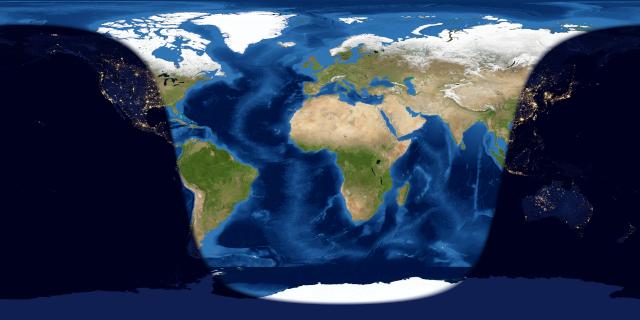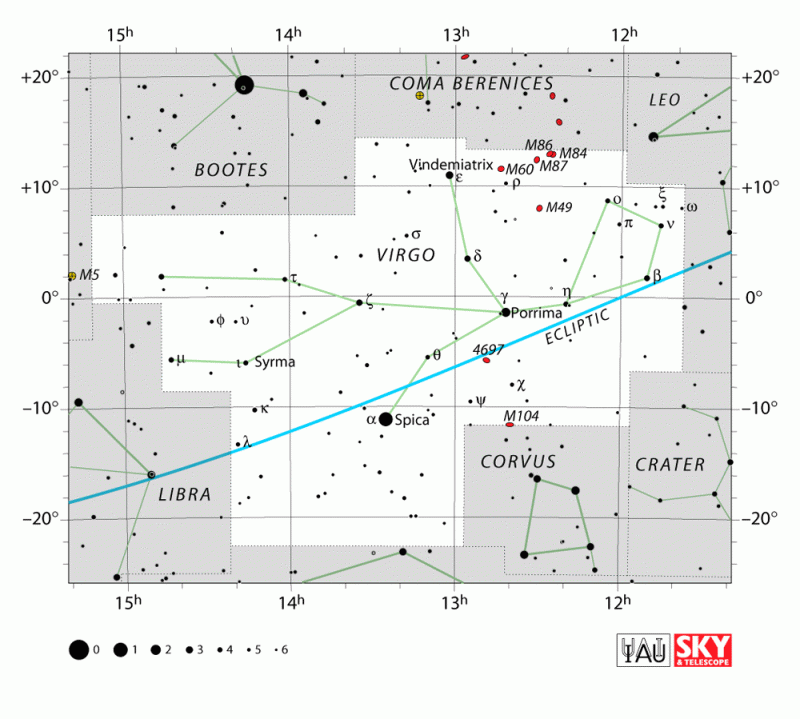
On both April 18 and April 19, 2019, you’ll see a round full-looking moon in your sky. The moon turns full in front of the constellation Virgo the Maiden at 11:12 UTC on April 19. That means that, from some places worldwide, the moon turns full before dawn on April 19. More about the precise time of the full moon shortly.
As darkness falls around the world on April 18, it’ll be an almost-full waxing gibbous moon in the neighborhood of Spica, the constellation Virgo’s one and only 1st-magnitude star.
Now back to that full moon time. If you live in Alaska, the western portions of Canada or the United States, Mexico or South or Central America, this full moon instant actually happens before (or at) dawn April 19. At North American and U.S. time zones, the moon turns full during the morning hours on April 19, at 8:12 a.m. ADT, 7:12 a.m. EDT, 6:12 a.m. CDT, 5:12 a.m. MDT, 4:12 a.m. PDT, 3:12 a.m. Alaskan Time and 1:12 a.m. Hawaiian Time.
By definition, the moon is full at the instant that it’s exactly 180 degrees away from the sun in ecliptic longitude. Or another way of putting it, the sun-moon elongation equals 180 degrees at full moon. Click here to find the sun-moon elongation at this moment, keeping in mind that a positive number refers to a waxing moon and a negative number to a waning moon.
Technicalities aside, however, the moon appears full to the eye for a few days. That’s because at the vicinity of full moon, the moon remains more or less opposite the sun for a day or two. From around the world, expect to see a full-looking moon lighting up the nighttime from dusk until dawn tonight (April 18) and tomorrow night (April 19).
Want to know when the moon turns precisely full at your time zone? Click here and remember to check the moon phases box.
See worldwide map below for more details.

The day and night sides of Earth at the instant of full moon (April 19, 2019 at 11:12 UTC). The shadow line at left (running through North America) depicts sunrise April 19, and the shadow line at right (running through eastern Asia) represents sunset April 19. For the eastern parts of North America, the sun is above the horizon and the moon is below the horizon at the instant of full moon. Image via EarthView.
In the Northern Hemisphere, we often call the April full moon the Pink Moon, to celebrate the return of certain wild flowers. Other Northern Hemisphere names for this full moon are Egg Moon, Sprouting Grass Moon, or Easter Moon.
In the Southern Hemisphere, where it’s autumn, this April full moon counts as the Southern Hemisphere’s Hunter’s Moon – the full moon that immediately follows the Harvest Moon. One month ago, the full moon on March 21, 2019, was the Southern Hemisphere’s Harvest Moon because it was the closest full moon to the southern autumn equinox. The Harvest and Hunter’s Moons usher in a procession of moonlit nights, because the moon rises fairly soon after sunset for several nights in a row. If you live at middle or far southerly latitudes, enjoy your April Hunter’s Moon.
Read more about the March 2019 equinox full moon
By the way, last month’s full moon also shone in front of the constellation Virgo. So, in 2019, we have two full moons in a row taking place in front of the same constellation: Virgo. Each full moon recurs about 30 degrees east of the previous full moon, as measured by the background stars of the zodiac. Even so, it’s possible for two full moons in a row to occur in Virgo, because Virgo is the largest constellation of the zodiac and the second-largest overall.
Click here to know which constellation presently backdrops the moon.
From the perspective of the Northern Hemisphere, Virgo is absent from the early evening sky starting in autumn and throughout the winter. But Virgo’s return to the sky at nightfall coincides with the verdant season of spring.

The sun spends far more time in front of Virgo than any other constellation. This year, in 2019, the sun enters Virgo on September 17 and leaves Virgo on October 31. Sky chart of the constellation Virgo via the IAU (International Astronomical Union).
Bottom line: Enjoy the April 2019 full moon on either April 18 or 19. At the crest of full phase, it shines in front of the constellation Virgo the Maiden.
from EarthSky http://bit.ly/2VR7pU1

On both April 18 and April 19, 2019, you’ll see a round full-looking moon in your sky. The moon turns full in front of the constellation Virgo the Maiden at 11:12 UTC on April 19. That means that, from some places worldwide, the moon turns full before dawn on April 19. More about the precise time of the full moon shortly.
As darkness falls around the world on April 18, it’ll be an almost-full waxing gibbous moon in the neighborhood of Spica, the constellation Virgo’s one and only 1st-magnitude star.
Now back to that full moon time. If you live in Alaska, the western portions of Canada or the United States, Mexico or South or Central America, this full moon instant actually happens before (or at) dawn April 19. At North American and U.S. time zones, the moon turns full during the morning hours on April 19, at 8:12 a.m. ADT, 7:12 a.m. EDT, 6:12 a.m. CDT, 5:12 a.m. MDT, 4:12 a.m. PDT, 3:12 a.m. Alaskan Time and 1:12 a.m. Hawaiian Time.
By definition, the moon is full at the instant that it’s exactly 180 degrees away from the sun in ecliptic longitude. Or another way of putting it, the sun-moon elongation equals 180 degrees at full moon. Click here to find the sun-moon elongation at this moment, keeping in mind that a positive number refers to a waxing moon and a negative number to a waning moon.
Technicalities aside, however, the moon appears full to the eye for a few days. That’s because at the vicinity of full moon, the moon remains more or less opposite the sun for a day or two. From around the world, expect to see a full-looking moon lighting up the nighttime from dusk until dawn tonight (April 18) and tomorrow night (April 19).
Want to know when the moon turns precisely full at your time zone? Click here and remember to check the moon phases box.
See worldwide map below for more details.

The day and night sides of Earth at the instant of full moon (April 19, 2019 at 11:12 UTC). The shadow line at left (running through North America) depicts sunrise April 19, and the shadow line at right (running through eastern Asia) represents sunset April 19. For the eastern parts of North America, the sun is above the horizon and the moon is below the horizon at the instant of full moon. Image via EarthView.
In the Northern Hemisphere, we often call the April full moon the Pink Moon, to celebrate the return of certain wild flowers. Other Northern Hemisphere names for this full moon are Egg Moon, Sprouting Grass Moon, or Easter Moon.
In the Southern Hemisphere, where it’s autumn, this April full moon counts as the Southern Hemisphere’s Hunter’s Moon – the full moon that immediately follows the Harvest Moon. One month ago, the full moon on March 21, 2019, was the Southern Hemisphere’s Harvest Moon because it was the closest full moon to the southern autumn equinox. The Harvest and Hunter’s Moons usher in a procession of moonlit nights, because the moon rises fairly soon after sunset for several nights in a row. If you live at middle or far southerly latitudes, enjoy your April Hunter’s Moon.
Read more about the March 2019 equinox full moon
By the way, last month’s full moon also shone in front of the constellation Virgo. So, in 2019, we have two full moons in a row taking place in front of the same constellation: Virgo. Each full moon recurs about 30 degrees east of the previous full moon, as measured by the background stars of the zodiac. Even so, it’s possible for two full moons in a row to occur in Virgo, because Virgo is the largest constellation of the zodiac and the second-largest overall.
Click here to know which constellation presently backdrops the moon.
From the perspective of the Northern Hemisphere, Virgo is absent from the early evening sky starting in autumn and throughout the winter. But Virgo’s return to the sky at nightfall coincides with the verdant season of spring.

The sun spends far more time in front of Virgo than any other constellation. This year, in 2019, the sun enters Virgo on September 17 and leaves Virgo on October 31. Sky chart of the constellation Virgo via the IAU (International Astronomical Union).
Bottom line: Enjoy the April 2019 full moon on either April 18 or 19. At the crest of full phase, it shines in front of the constellation Virgo the Maiden.
from EarthSky http://bit.ly/2VR7pU1

Aucun commentaire:
Enregistrer un commentaire